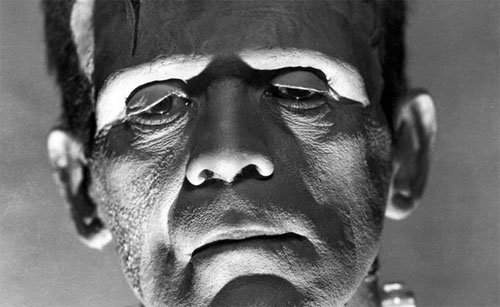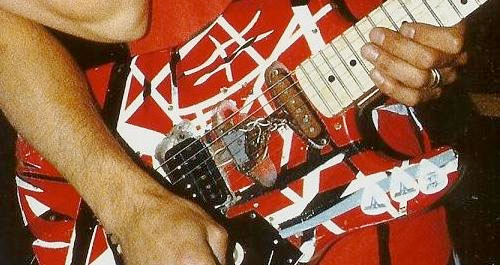EVH Frankie Wood Mystery Deepens…
…A Little
What exactly was the body wood of Edward Van Halen’s Frankie guitar? That’s one of life’s unanswered questions. It’s literally possible no one knows anymore, and the forensics of guitar wood aren’t exactly a scientific discipline. But we just got one more little piece of this ongoing puzzle.
For years – decades – the speculation has centered on ash: northern ash (also known as “hard” ash) or swamp ash. Sometimes alder has come up as a possibility. I even read somewhere online that a guy called Wayne Charvel’s shop one day, Ed happened to be there and said Frankie’s body is alder. (I have a good ‘80s Warmoth Strat body, and while it gets close – real close – to Ed’s tone, it’s not all the way there. So IMO Frankie is not alder.)
Most diehard EVH tone fans have been in the northern ash camp because the brightness of northern ash fits with Ed’s tone. Typically, northern ash is densely-grained and heavy, like Les Paul heavy. In contrast, swamp ash – apparently the same species of tree, just growing in a warmer climate – is lighter. Both have a characteristic twang or “presence” (in the amp sense) that some folks like and others consider harsh.
Exhibit 1: $25K Frankie Replica
I’m sure you all remember the $25,000 Frankie replicas that came out a few years ago (now occasionally selling for about half that on eBay, still not cheap!). One characteristic of these guitars that has been noted by the people who’ve played them is they’re light – which led to the following questions:
- > Since the body wood is light in weight, could it really be northern ash?
> If it’s too light to be northern ash, is it swamp ash – or something else?
On question 1: Technically, yes. Northern ash bodies aren’t always super heavy, particularly if a body has dried out – as it would if painted with bicycle paint and not really sealed, and played under stage lights for years.
So when these $25K guitars came out, the speculation was that the bodies were light because Eddie’s northern ash body had dried out over the years.
I’m definitely no wood or guitar-making expert, but while I know guitars will dry out and lose some poundage, I’m not sure how much weight they can actually lose, particularly if we’re talking about northern ash.
A couple examples:
- > I have a 1980 Les Paul Standard, my #1 guitar, that still weighs a ton even though it’s 30 years old and has seen a lot of clubs.
> I’ve played ’70s Fender Strats with northern ash bodies that could have been made from iron: Heavy.
If we subscribe to the theory that Frankie was heavy northern ash to start, then using the above two examples I find it hard to believe those guitars lost, say, half their weight in that time – meaning they would’ve been about 18 to 20 pounds when new. No way!
Northern ash also means a denser grain (hence the weight), and I believe less moisture typically than swamp ash – if true, then less loss of water weight possible. So then how much weight could Frankie’s body have really lost over the years.
And bear in mind that even though Edward was and is a strong dude, he has a small frame – I find it super unlikely that he would choose to wear a 10- or 12-pound guitar night after night no matter how it sounded. Not without commenting on the weight, anyway, which he never did.
Exhibit 2: This Just In
Just last night I was reading on the metroamp.com board a post by Jas Obrecht. You might recognize the name – he was a writer for Guitar Player magazine, and interviewed Edward several times. Jas posted a link to his site with a rundown of Ed-related interviews and info, and somewhere in there it came to light that he’d held Frankie back in ’78.
A particularly astute forum member who goes by Strat78 jumped right on that and asked Jas whether the guitar, when he held it back then, was heavy or light. The answer: light.
Where Are We Now?
So that brings us to question 2: Does the light weight of the $25K Frankie replicas AND the actual Frankie mean the body could’ve been swamp ash, or even something else? The answer of course is who the heck knows.
Ed likes basswood now (he appears not to like alder), with a maple top. Many people have said that wood combo is sort of like a Les Paul (mahogany body, maple top), and have speculated that Ed is trying to return to that sort of tone – “return,” meaning he played Les Pauls a bunch in the early days, including a Les Paul Junior in clubs.
But it could mean basswood doesn’t give Ed the brightness he likes (as ash has), so he needs a maple top on it.
Bottom line is thanks to Jas, we have some more info, still nothing definitive. And I bet even if Ed himself told the world that he was sure Frankie’s body was northern ash, and was nutty enough to take a polygraph to confirm it, some people still wouldn’t believe him.
Notable
Tr, Pr on 10
We all know that Ed played a Marshall plexi with every knob set on 10. Try that sometime, or at least try playing through any decent amp with Presence and Treble both on 10. It’s harsh and tough to control, but IMO is the only way to get some of Ed’s tone. You’ll know what I mean when you hear it.
And remember, guit-players playing alone usually like more bass in their tone – that’s one reason for all that bass on amps these days. But in a band situation, a bassy tone either gets lost, sounds like crap or if loud enough takes up too much of the mix. Ed’s early tone definitely was not bassy, and in fact might have sounded pretty harsh if you had to listen to it by itself.
Just in case you want to try it…
Neck Tone, Cable
Also remember that Frankie originally had a fat, wide neck. If you’ve ever played a guitar with such a neck or swapped out a thin neck for a wider and/or fatter one (one with more wood), you’ll probably hear better overall tone, and a little bit fatter, rounder tone overall.
That might have helped to kill some of the harshness of his early guitar/rig, along with all that guitar cable he used back in the day.
Category: Alder, Basswood, Edward Van Halen, Guitar woods, Northern ash, Swamp ash
















I absolutely LOVE this website…
So supposedly Frankie had a fat wide neck; the Frankie clone has a nut witdh of 1 5/6 ". According to Warmoth this is the skinniest of nut widths and is considered vintage with 1 11/16" being the modern standard. I would have thought Eddie had a 1 3/4" neck.
That's because it's the neck most recently on that guitar. The nut width originally was 1 3/4.
I take it Eddie changed his mind about a few things. That in itself would make a good post, hint, hint…
I wonder if his new equipment is equipment he would have been happy with back in 1978. I wonder how much age had to do with his current neck choice.
Around 1987 while I was working with Tom Anderson we had the pleasure of working on Edward’s Frankenstein guitar. We were making guitars for Steve Ripley and became the artist shop for Kramer Guitars. Frankie had a Kramer neck on it at the time – the same neck from the US Festival – and Edward asked if we could put a neck on it like the Ripleys. We put an 1 11/16 nut width Explorer headstock neck on it and had to increase the butt end width by 0.040″ to fit in the oversized neck pocket to keep it from moving. The body was definitely ash, and though not heavy, the guitar was in the 9-10 pound range. I took some photos of our work, but – unfortunately – did not fully document every detail of the guitar. I did get the chance to play the guitar daily for the few months we had it in the shop. That was the kick of a lifetime!